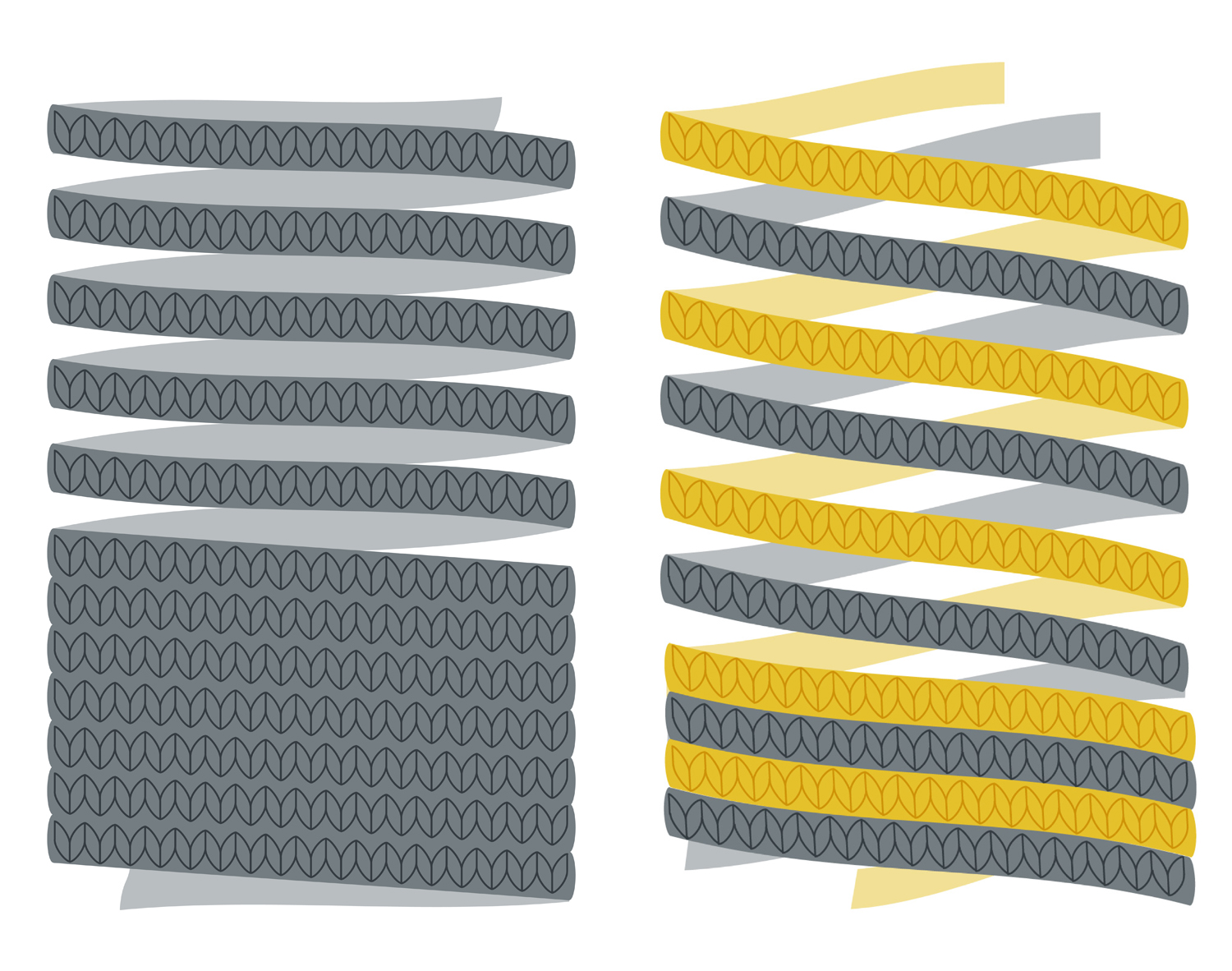As I mentioned yesterday, one of the ways in which helical stripes differ from traditional stripes is that they make the fabric slant. The more rounds you have in your stripe pattern, and the smaller the circumference of your knitting, the more the stripes appear to slant in the fabric. I absolutely love the effect this gives when you push it as far as you can, and I struggle to see how else you would achieve this look in your knitting.
Read moreTwiss cowls
Lots of knitters have asked me about how to work multiple round stripe patterns helically. In fact, this question is one of the things that motivated me most in writing the Something New to Learn About Helical Knitting ebook. The Twiss cowls are really my answer to the question of how to work stripes with more than 1 round in each colour. The pattern includes details on how to work 3-, 4-, 5-, and 6-round stripe repeats, including patterns where you work more than one round in each colour.
Read moreWorking helically
I’m sitting at my desk, surrounded by helical knitting swatches and samples. In case it wasn’t already obvious, I’m rather in love with this unusual technique! As I’ve published helical designs, there are a few questions that have popped up regularly, and one of the most common themes is around working other instructions at the same time as working helically.
Read moreHelical stitch patterns and a pair of cowls
It has been brilliant to see a number of people in the helical knitalong saying how magical they are finding 1x1 helical stripes. It’s this sense of wondrous ease, and yet cleverness that has driven the development of the stitch patterns in today’s new chapter of Something New to Learn About Helical Knitting. I had already dipped my toe in the water of helical stitch patterns with my Spiralling Socks designs. They use the combination of a knit round and a slipped stitch pattern to create a pleasing helical effect, and I was quite sure that there must be plenty of other patterns that would be fun to work in this way.
Read moreOn the naming of patterns – part 2
Double helix staircase at the Chemistry department of the University of Reading. Image © Jen Arnall-Culliford
I had the pleasure of a trip to visit Felicity (Felix) Ford at Knitsonik HQ a couple of weeks back. We are making mischievous plans for next year, and after lunch we decided to go for a walk before I headed back to Frome. By complete happenstance, Felix’s route took us through the campus of the University of Reading, so we made an abrupt change of plans and went to visit the Chemistry and Pharmacy department, which is home to a double helix staircase. Read more to find out about the double and triple helix staircases that provided the names for the patterns in Something New to Learn About Helical Knitting.
Read moreBasic Helical Stripes and the Bramante Cowl
Today we are releasing the first chapter in Something New to Learn About Helical Knitting.
Chapter 1 starts at the very beginning. Of course!
If you have never worked helically before, this is the chapter for you. If you’re already a helical fan, then don’t worry, there are plenty of new explorations for you in the later chapters. The first chapter is the knitting equivalent of the first term at a new school or university, where we make sure that everyone is up to speed on the foundations, before diving into the wider subject.
Read moreSomething New to Learn About Helical Knitting
Intrigued by the idea of helical knitting? Have you knitted 1x1 helical stripes, but would like to know more about working more complex stripes? Would you like to know more about using helical stitch patterns? Or are you just keen to try something new in your knitting? Then this is the ebook for you!
Something New to Learn About Helical Knitting will be delivered as an ebook in four fortnightly chapters, with the first being released on Tuesday 9th October.
Read moreThe fun to be had in knitting helically
Whilst jogless stripes are the most well-known application of helical knitting, I have become captivated with other possibilities for helical stitch patterns. Working helically is just (in my humble opinion) a heap of fun. It’s satisfying and simple, and at the same time can create quite complex fabrics with a minimum of fuss.
Helical knitting is sometimes a solution to a problem, but in other situations it’s just an elegant approach to a stitch pattern.
Read moreOn the naming of patterns...
Jim and I love almost every aspect of running Arnall-Culliford Knitwear, but one of the tasks that we procrastinate the most is the naming of patterns. There are so many things to think about when you choose a pattern name. Has it been used before? Does it relate to the design in question? Is there a theme to the collection and does the name fit with the theme? And most importantly, does the name have unexpected connotations, both here in the UK and internationally? When I’m thinking about a pattern name I have learned the hard way to look it up on Google as well as Ravelry. I once worked on a collection where one of the patterns now shares a name with a cream used for a rather unspeakable ailment…
Read moreSo what is helical knitting?
Image © Mimi Codd.
When you knit in the round, you aren’t working discrete, complete rounds, in the same way as you would work a row in flat knitting. Your knitting isn’t a series of rings of stitches sat on top of each other. Instead, in each round you are working a complete circuit or 360° turn of a helix. This is important because it means that the first stitch in your round is not adjacent to the last stitch in your round. In normal knitting you work a single, complete spiral of stitches, where the last stitch of the previous round is adjacent to the first stitch of the next round. Helical knitting turns this on its head, and sets up multiple spirals all sitting on top of each other.
Read more





